
BREAKS-AIR
TRUCK SERVICE MANUAL
To test for leakage, apply 100 p. s. i. air pressure
Place a new rear end cover gasket in position over
through the discharge port of the cylinder head and apply
studs on rear end of crankcase being sure the oil
soap suds to the discharge valve openings in the floor of
hole in the gasket lines up with the oil hole in the
the cylinder head. Leakage should not exceed a one
crankcase. If end cover includes an oil seal ring, install
inch soap bubble in not less than five seconds.
oil ring. Position end cover over studs in crankcase
being sure oil holes in end cover line up with oil
A
If excessive leakage is found, leave the air
holes in gasket and crankcase. Install capscrews or nuts
pressure applied and using a fiber or hardwood dowel
securing end cover in place.
and light hammer, tap the discharge valves off their
Install pipe plugs in end cover oil openings which are not
seats several times to improve the seal between the
in use.
valves and their seats. If the valves and valve seats
have been reconditioned properly, this will reduce the
If opposite end cover includes an oil seal and the
leakage.
seal has been removed, press a new seal in the end
cover. Install a new end cover gasket. Carefully position
Leakage tests must also be made by applying
the end cover to avoid damage to oil seal and install
soap suds around the discharge valve cap nuts with air
capscrews or nuts securing end cover in place, Fig. 9.
pressure applied as above. Leakage at cap nuts is not
permissible.
Inlet Valves and Seats
If inlet valve seats show signs of slight scratches
or wear, they can be reclaimed by using a lapping stone
and grinding compound.
If the seats cannot be
reclaimed in this manner, they should be replaced.
Install new inlet valve seats by pressing them into
cylinder block to dimensions shown in the specifications.
Inlet valves not worn excessively or damaged can
be reclaimed by lapping them on a piece of crocus cloth
on a flat surface.
REASSEMBLY
Installing Cylinder Block
Fig .
9 Sectional View of Block and Crankcase
Place new cylinder block gasket in position on
crankcase studs. Position cylinder block on crankcase in
Assembling Pistons and Connecting Rods
accordance with markings made before disassembly.
Install nuts and lock washers securing cylinder block to
If wrist pin bushings have been removed from
crankcase.
connecting rods, press new bushings into place making
sure that the oil holes in the bushings line up with the oil
Installing Cranks haft
hole in the connecting rods. Bushing must then be
reamed, honed or bored to provide the proper running
If the crankshaft is fitted with oil seal rings, install
clearance on the wrist pin as shown in the specifications.
rings.
Position ball bearings and crankshaft in
Position connecting rod in piston and press wrist pin into
crankcase, being sure the drive end of the crankshaft is
position with lock wire holes in pin aligned with lock wire
positioned as marked before disassembly. If one end of
hole in piston. Install new wrist pin lock wire in wrist pin
the crankcase is counter bored for holding bearing, be
so that the long end extends through piston and wrist pin
sure the crankshaft is installed through the correct end of
and short end can be snapped into the lock wire hole
the crankcase. Carefully press crankshaft and bearings
near the bottom of the piston skirt, Fig. 10. Do not use
into crankcase using arbor press.
pistons in which the wrist pin is loose.
132

